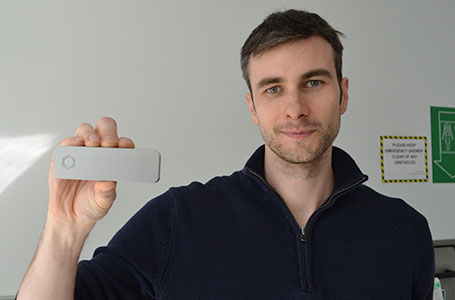Could this technology be the key to monitoring the spread of Zik
As West Africa was dealing with a massive outbreak of the Ebola virus, a group of researchers answered the call for assistance with a palm-sized device. Dr. Nick Loman and Mr. Josh Quick from the Institute of Microbiology and Infection at the University of Birmingham in the U.K., together with the help of OICR Investigator Dr. Jared Simpson, developed a ‘genome sequencing lab in a suitcase’ based around the tiny MinION sequencer. It was deployed to Conakry, Guinea in April of 2015 to test Ebola samples in the field.
Loman and Quick have been driving the development of new applications for the MinION for some time and have an interest in seeing how pathogens spread. However, using the MinION in new applications is not as simple as loading samples into the device. The MinION reads DNA by measuring the changes in electric current caused by DNA going through a nanopore. These subtle changes, measured in picoamps, are inherently noisy and challenging to analyze. Loman asked Simpson, his long-time colleague, to develop the algorithms needed to find mutations in the Ebola samples. Simpson developed a probabilistic model to solve this problem and made it available to the entire genomics community as open source software called nanopolish.
The advantage of having this portable system was that samples could be processed much more quickly…
Simpson’s first MinION project with Loman and Quick was to sequence and assemble the genome of the E. coli bacteria. “By doing this research the team was able to demonstrate the capabilities of the MinION and develop the methods needed to reconstruct complete genomes using the device,” explains Simpson.
When the Ebola outbreak occurred in 2014, Loman and Quick saw the potential of having the technology in the field to track the Ebola virus. They partnered with Public Health England and Quick volunteered to travel to Guinea to set up the sequencing lab to help epidemiologists track and contain the outbreak. (Read a blog post by Loman about the logistical and practical concerns of preparing to deploy)
Having the ‘lab in a suitcase’ in Guinea proved very useful. “They were able to sequence 142 samples while there, which helped experts see how Ebola cases between patients were related and to track the spread of the disease,” explains Simpson. “The advantage of having this portable system was that samples could be processed much more quickly than if they had to be shipped to a lab with larger, more complex equipment.”
Both the E. coli study and the Ebola fieldwork have shown that the MinION is emerging as a useful tool for both research and clinical use. Simpson notes that there is now interest in using the system to track the Zika virus outbreak in Central and South America. “It can be used on any virus or bacteria but the challenge is having the teams in place that can get samples to the sequencer.”
…the Ebola fieldwork have shown that the MinION is emerging as a useful tool for both research and clinical use
Simpson says there are many uses for the MinION technology besides sequencing viruses in exotic locales, “In terms of cancer it will initially be used for discovery research, but it also has the potential to be used in a clinical setting. The technology will be scaled-up by increasing the number of nanopores on the device to create a desktop-sized machine that might be used in a hospital lab.” Whether it is in a field lab in West Africa or a lab at OICR, the tiny MinION is having a big impact.

